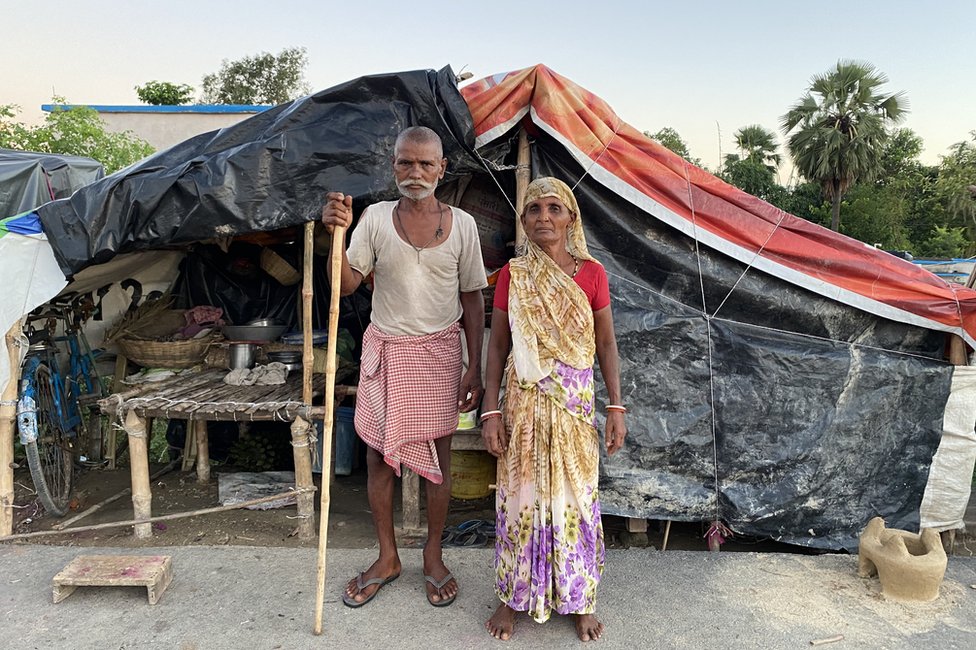[ad_1]
By Priyanka Dubey
BBC Hindi, Bihar

Bihar, a poor, populous state in northern India, is ravaged by floods during the monsoon season every year. This year has been no different, with some seven million people affected.
I travelled through some of the worst-hit districts, where heavy monsoons and swollen rivers have swept away homes and livelihoods.
Day 1, West Champaran
The first thing I noticed while driving through Bihar’s West Champaran district was the flood water lapping against the road on both sides. Mud houses, treetops and vast fields of rotting sugarcane were all submerged in the Burhi Gandak river, better known in these parts as Sikrahana.
My shock at the devastation only grew when I reached my destination – a tiny village of 41 families called Matiyar that had nearly drowned in the waters.
Seventeen of the families are Muslim, while the remaining are Dalit (formerly known as untouchables), who are at the lowest rung of India’s unyielding caste system.
All of the families in Matiyar are impoverished. When I met them, they had moved to a thin strip of road that ran through the village, fitting what was left of their lives into tiny tarpaulin tents.
Young boys were showing each other videos of snakes that had been killed – snake bites during heavy rains are common in India, and many Indians die from them every year.
While cooking potato curry for her family of six on a temporary brick stove, Nageena Devi told me that she stays awake the whole night watching for snakes.
“They slip into the tent sometimes and start crawling over us while we are asleep. We are scared for our children so we spend the night sitting on chairs, watching out for them.”
And yet she was sympathetic to their plight. “But where will these poor snakes go? In the middle of this flood, they are as homeless as we are.”
Day 2, East Champaran
I stood in front of Bhawanipur, a village that had been abandoned to the roaring waters of the Gandak river.
It was one of seven villages that had been engulfed on the night of 23 July when the embankment nearby broke.
Villagers had left their half-submerged homes and moved on to the bit of the embankment that was still standing.
I walked across a slushy path under the scorching sun to reach the embankment. Hundreds of people had moved there with whatever belongings they could gather in their hands. Farmers were still weeping over sacks of rotten grain.
The few cattle they had managed to save stood in front of their makeshift tents.
Lallan Mukhiya, a local fisherman, took me to his now broken mud house where he had lived with his four brothers.
“My house is completely destroyed,” he said, showing me around. He added that they had only got 2kg of puffed rice, and 0.5 kg of sugar as “aid” from the government.
When I was about to leave, his five-year-old son, Prince, invited me to eat lunch with him.
I said I couldn’t because I had to keep travelling.
Day 3, Darbhanga
India’s National Highway 57 felt less like a road and more like a bridge. I was told that the route was once flanked by fields dotted with houses, all of which were now under water.
This particular highway was flooded by not one but many rivers – Sikrahana, Baagmati and Avdhara to name a few. Agriculture is still the mainstay in Bihar, a fertile, flat land, drained by several rivers – a blessing that is also a curse.
Soon, I saw hundreds of black tarpaulin tents pitched in small clusters on the edges of the road. Here, villagers did not fear venomous snakes. They said their enemy was traffic. Just the day before, two people had been injured in an accident, while asleep.
Pradeep Mehto compares his life on the highway to that of a dog. “Just like dogs wake up at the slightest sound, we also wake up. The whole night we are scared that a bus or truck will run over us. I have not been able to sleep since we moved here.”
Day 4, Samastipur
The Saidpur relief camp in Samastipur district is easily visible from a distance.
Hundreds of families – or approximately 2,000 people – live there in plastic tents with no access to toilets. Women would fetch water from one of only three hand pumps, while men walked their cattle around the camp. Refuse was strewn everywhere.
When I visited the camp, the first and only meal of the day was being served. People formed rows for their share of a thick stew of pulses and rice that had been cooked in the makeshift community kitchen.
They ate their meal from disposable plates, while sitting in the dirty slush. My eyes were drawn to an elderly man who struggled to swallow what was on his plate.
Day 5, Muzaffarpur
As I drove towards the village of Singhai, I saw the floating tops of submerged temples, mosques, houses, fields and trees.
It is the first time in four decades that this part of Muzaffarpur district has witnessed such massive floods.
Those who could afford to had left the village and moved to the district headquarters. But others were forced to move to a strip of the embankment that had survived the flooding.
While walking on it, I met 45-year-old Shivendra Mehto, a daily-wage labourer who lived in a small tent with his family of 13.
He walked with me, dragging along his old broken cycle.
“I kept a table on the bed and then a chair on the table – and then we sat on it through the night to escape the flood waters. No help came.”
Now, he said, he had lost everything. He had already lost his job because of the pandemic.
“I don’t know how I am going to feed my family in days to come.”
[ad_2]
Source link